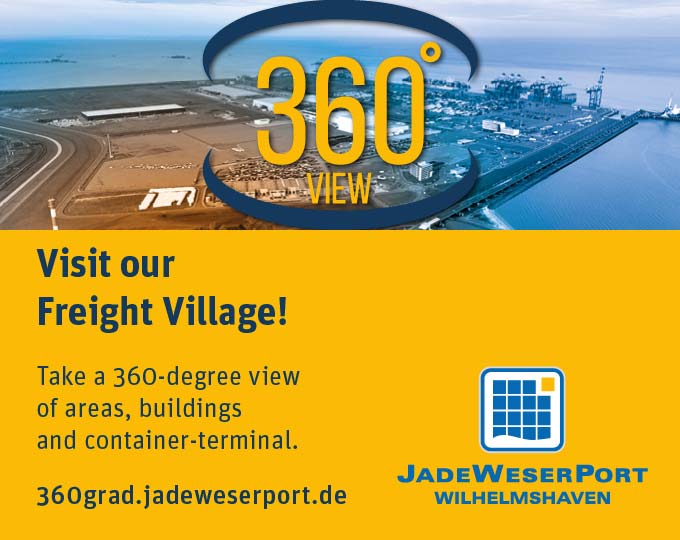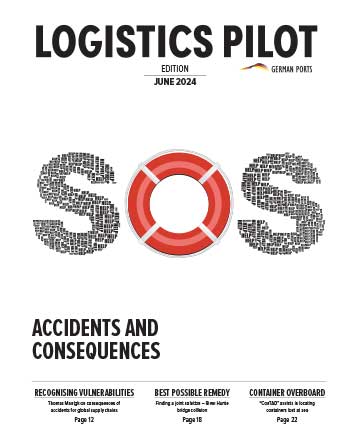Christoph Kolter has been port captain of the Port of Emden since last April and thus the central point of contact for shipping companies, customers and service providers in Germany’s universal port in the far west.
Credits: NPORTS, CLAUDIA BEHREND; Grafik: NPORTS
When port captain Christoph Kolter introduces people to the Port of Emden, people sometimes comment on the surprisingly large size of the area. And with good reason. Combining the non-tidal inland port, which has been built up over the years, and the modern outer port, it comes to a respectable 1,163 hectares. This makes Emden Germany’s third largest seaport – making the new port captain quietly proud. After all, since June last year, Kolter and his 35-person-strong team have been responsible for ensuring that everything runs smoothly in the port on the north shore of the Ems.
In fact, this is not the only role that the 46-year-old has, but actually one of three. For example, as port captain he runs the port office in Emden, where he and his team at NPorts manage shipping traffic, assign berths, operate locks and are responsible for the settlement of port charges, amongst other duties. In addition, Kolter performs the tasks of the port authority in Emden on behalf of the Lower Saxony Ministry of Economy, Employment, Transport and Digitalisation. Administrative duties include, but are not limited to, port and shipping security, port and port facility security, proper ship waste management under the International Convention for the Prevention of Pollution from Ships (MARPOL), and the transport of dangerous goods within the port. Moreover, Kolter, who comes from Emmerich am Rhein, is also head of the local port security authority – not just for Emden, but also for Leer and Papenburg.
Hazard protection in port and shipping activities
An important area of responsibility is general hazard protection. Officialese that seems abstract to most is not only highly relevant but often also highly challenging in the daily work of the port captain: “I consider whether port authority permits should be issued, for example, if deep-sea ships are to be unloaded against the tide,” said Kolter. In strong winds when large ro-ro ships enter the port like the “Malacca Highway”, belonging to the Japanese shipping company K-Line with space for 1,811 vehicles, the service’s navigator will check whether entry or exit could become critical due to the large sailing area of such car carriers. “Normally, the captains pay attention to this themselves, but we prefer to play safe.”
Another example is getting particularly large ships and other vessels through locks, like a pontoon we had some time ago. It was designed to transport a 43-metre-wide lattice structure for fish farming in a Norwegian aquafarm from the inland port through the lock to the outer port, though the lock width was only 40 metres. If you consider the safety clearance space required and the width of the fenders, the passage width is even less than this. But by transporting the construction on the pontoon and avoiding the quay, we made it work.
Before Kolter gives the necessary approval, he carefully runs through the processes with all those involved. “In this case, I got advice from a senior of the pilots association, agreed with the responsible engineers of the company and then formulated the conditions,” said Kolter. Specifically, this meant the company had to firstly run through the process in the simulator and the tugboat crew subsequently received advice from the navigators. “It was so tight, we even had to dismantle warning boards and fence installations,” recalls the port captain. “In the end, everything worked out well.”
Port security
It was recently very clear just how diverse Kolter’s area of responsibility is, and what falls under the territory of security. “In one instance, a protest march was due to pass over a lock,” reports Kolter. “However, we are faced with a nautical problem when a ship is incoming and cannot enter because the lock gate cannot be opened. Depending on the wind, the ship may not be able to stop.” The decision to authorise the route is therefore also taken by the port captain and the harbour police.
These examples show how varied the job of the port captain is: “Every day is different and brings new issues, so you have to be careful that you are able to keep on top of things,” states Kolter. Routine and standardised processes help here. In the morning, Kolter and his deputy Christof Lingelbach are usually told about overnight events by the watchkeepers. After that, emails have to be checked and the day-to-day schedule and upcoming dates discussed and agreed upon between the port captain and his deputy.
If both colleagues are on duty, there is a clear distribution of tasks: “My deputy takes care of the port authority permits and is more involved at personnel-level, and he handles internal issues. I look after the scheduling of external appointments with everyone who is based in the port,” explains Kolter. “But basically we both do the same work and represent the port.” That is why it was not a big change for him when, last year, he officially took over the port office in Emden after seven years as deputy port captain in Emden and Cuxhaven.
The job of port captain is not only influenced by his work with his colleague and the team, but also with a wide range of authorities such as the harbour police. Amongst other things, he also acts as a law enforcement authority for administrative offences in the case of accidents. To authorise the use of LNG, which is possible from truck to ship as well as from ship to ship, requirements were drawn up in collaboration with the trade supervisory board, the police, the fire brigade and a bunker company in Emden. But there are also IT interfaces, such as those to program the app allowing inland waterway users in Emden to check in by phone. Regarding shore power, NPorts has just enquired about all possible berths in Emden with Kolter.
Facts
Port office Emden
Duty: Port management
Port captain: Christoph Kolter
Employees: 35
More Information
Whether it is a matter of nautical issues, coordination with authorities or the correct handling of people and personnel – Kolter, who comes from a family of public officials, is equipped to tackle these requirements thanks to his studies in ship logistics at the University of Applied Sciences Emden/Leer as well as from his long-term professional experience as a naval officer and captain in commercial shipping on board cargo, multi-purpose and container ships. And he can even give a tour of the Port of Emden to visitors and shipping experts in Tagalog, the most widely used language in the Philippines, thanks to close personal connections.(cb)
Logistics Pilot
The current print edition - request it now free of charge.






